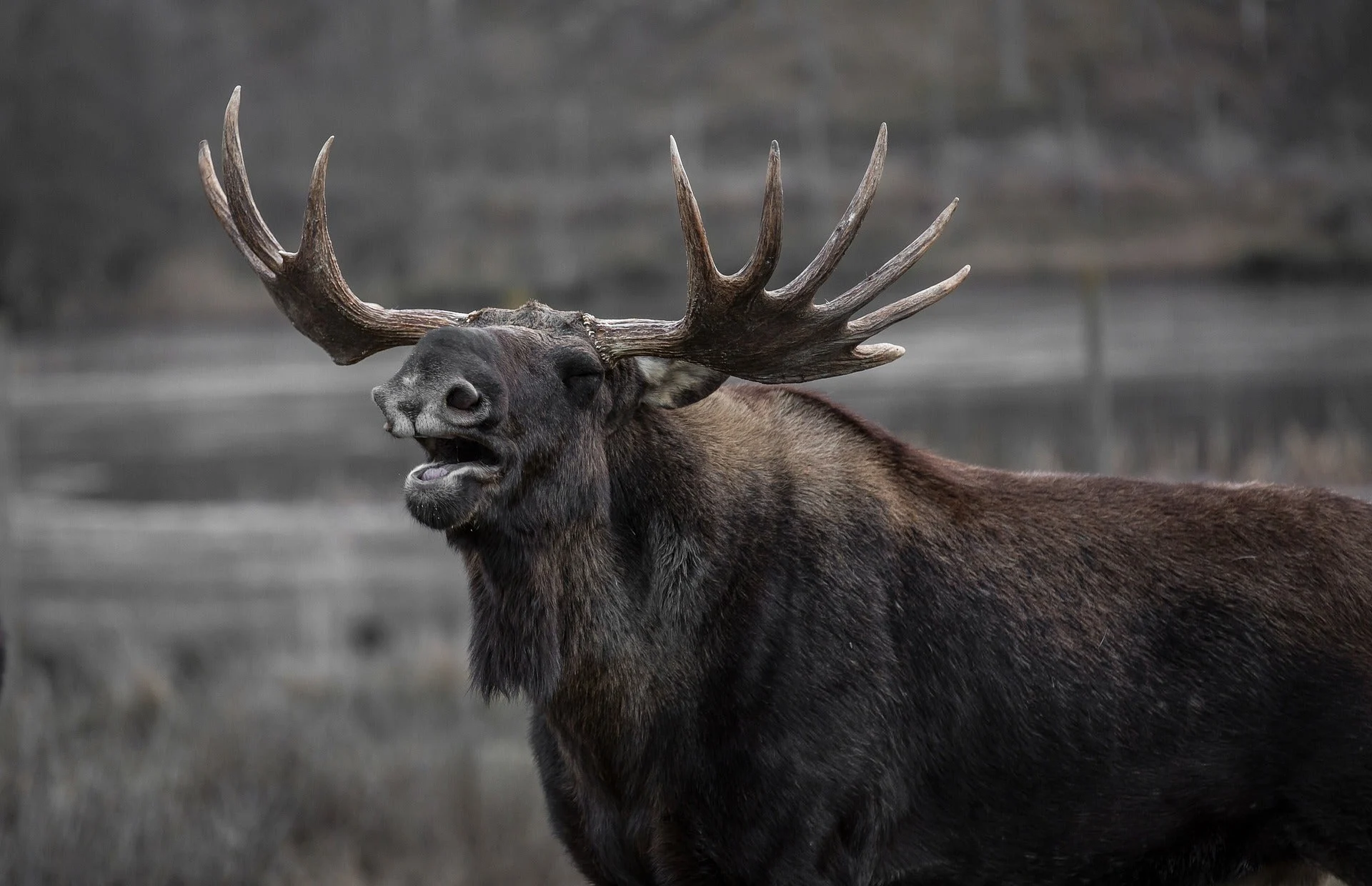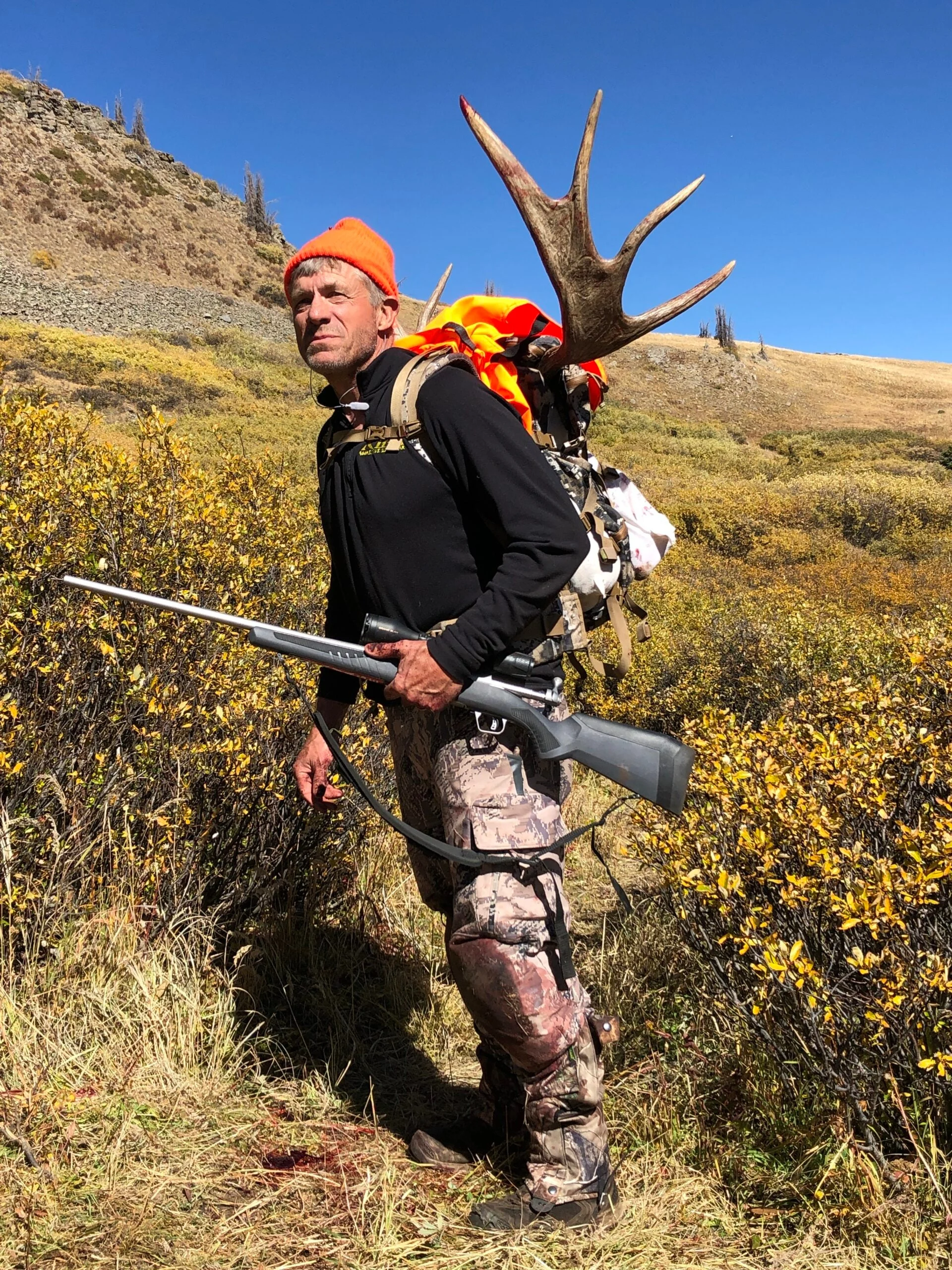_We may earn revenue from the products available on this page and participate in affiliate programs. Learn more ›
_
While I’ve never been the one behind the gun or bow, I have helped many friends fulfill their moose hunting dreams. I’ve always had an affinity for moose—their enormous size and impressive headgear are hard to ignore. Moose are the largest member of the deer family. They can weigh more that 1,000 pounds and have antlers more than 5 feet wide. They can also be one of the more difficult animals to hunt because of where they live, and their size. Packing a moose from dense woods can be a challenging task. But hunters who can do it are rewarded with a year’s supply of some of the best-eating game meat out there. The following moose-hunting guide is broken down by tactics. While terrain, subspecies, and environment may vary, tactics for hunting different kinds of moose are incredibly similar. Let’s dive in.
Table of Contents
The 4 Basic Moose Hunting Tactics
How to Gauge Whether Bull Moose is Legal
Don’t Be Undergunned
Have a Plan to Ready to Pack out Meat
The 4 Basic Moose Hunting Tactics
Moose Hunting Tactic #1 – Call a Moose
Moose use calls to communicate and find each other. This is especially so during the rut, from around mid-september to early October. During the rut, bull moose are highly responsive to calls. In general, you’ll use four kinds of calls to attract a bull moose.
During the pre-rut, early September, you can use a gluck. combined with the sound of thrashing brush. The gluck is a non-threatening noise that males make when the’re together. It’s enough to get male moose, still hanging out in bachelor groups, to give up their location with a call in return. You can make a gluck with your mouth and amplify the sound with a birch bark or commercial cone.
By mid september, the rut is on and bulls are fighting. You can lure bulls that are defending their territory and mates with a mu-whah sound. This technique is effective for lone bulls that don’t have cows, and they’ll want to try to steal your cows.

During the rut, bull moose can be more vocal. Tommy Takacs from Pixabay
From the beginning to end of the rut cow calls, nasaly moooooo-ah, sounds can be very effective. For all moose calls, most hunters do not use a diaphragm. Instead they’ll simply use their mouth and some kind of cone or their cupped hands to amplify the noise. Spend a little time on YouTube learning the various moose calls before the season starts.
When looking to call moose I like to gain vantage points to see open, swampy areas along willow-lined streams, near beaver ponds, the banks of prominent waterways, and vast openings in boreal and mixed deciduous forests. In some places, moose can be found above the treeline where there’s plenty of forage in the early fall, so don’t rule out high elevations.
Once you put your glass on a bull moose, take his temperature. Note the time of year. Is he passively feeding, or is he covering the ground with those large nostrils pointed into a stiff breeze looking for a cow? Is he wading in a beaver pond, or swaying his head and grunting? Is he alone or with a lady friend or other bulls? Depending on the situation, you’ll use the different calls above to bring in a moose.
Moose Hunting Tactic #2 – Use a Decoy
Moose have a terrific sense of smell, and as with all big-game critters, if you don’t play the wind, each hunt will be over before it begins. What sense fails them often, however, is their eyesight. The sight of moose paddle antlers or a female moose decoy can be enough to get a moose to close the distance and get in range. Decoys need to be used with the wind as moose will always try to smell what they’re looking at.
I’ve used a boat paddle over my head to decoy a moose, but I have also seen moose come to commercial decoys like Ultimate Predator Gear’s Stalker Moose. This decoy mounts to your bow and features an image of a cow moose printed on durable fabric with a lightweight spring-to-life metal frame. The decoy weighs 10 ounces and collapses to an 11-inch diameter for easy transport. If you want to turn your Stalker Moose Cow Decoy
into a bull, slap on the sold-separately antlers via Velcro attachment, become a bull, and go looking for a fight.
Be aware of your surroundings when using a decoy, especially a lifelike decoy. I don’t recommend a bow-mounted decoy or hiding behind a realistic decoy during rifle season. Use your decoy in combination with bull and cow talk. When calling and decoying moose, it’s important to remember that bulls don’t typically come in hot like a bull elk. Instead, the approach is slow and methodical, so stay patient.
Moose Hunting Tactic #3 – Blind-Calling
Blind calling involves calling without a bull in sight. I’d rather find a bull and gauge how he’s feeling before calling to him. But that doesn’t mean blind calling doesn’t work. But I know several guides in Maine and Vermont that hunt moose in areas of dense timber, and they blind-call often.
If you find an area with large rubs, tracks, and oversized moose droppings, but there are no moose in sight, find some shooting lanes and use a mixture of bull and cow talk. Most moose hunters that blind call heed the advice of predator hunters and stay after it for a half-hour to 45 minutes before moving on.
Moose Hunting Tactic #4 – Spot-and-Stalk
If you’re looking to punch your tag before the rut, spot-and-stalk is an excellent tactic. First, find the moose you want to go after, and early in the season, I like to glass willow-lined creeks surrounded by spongy, wet ground. Other solid locales include open hillsides where food is prevalent, long draws, and small aspen stands.
If you’re hunting during the early-season, take your time. Bull moose don’t travel much when they aren’t looking for a mate, and if you happen to find a bull right before evening, don’t fret. Moose aren’t big night-time travelers, and you should resume your search exactly where you left off the following morning.
When you go after a bull, pick landmarks to keep your way on the approach. Moose are relatively easy to stalk in comparison to other game animals. I find it easiest to use a digital mapping app like HuntStand or onX for spot and stalk hunting. Next, mark the position of the bull. Lastly, look at the topography between you and the moose. Drop pins in pre-determined locations and turn the tracking device on your app to on. This way, you can track your movement, get to your landmarks, and get close enough to kill.
Things change a bit during the rut, when moose move long distances in search of a willing cow. If you find a moose with his nose in the air, you need to get a move on, and you can proceed with a little less caution because the bull will be sniffing for a girlfriend. If you can stay somewhat hidden and close the distance quickly with the wind in your face, chances are good you can intercept the bull’s path of travel.

Make sure to bring enough gun for your moose hunt. Jace Bauserman
How to Gauge Whether Bull Moose is Legal
Some moose hunting units have antler size restrictions that are important to be aware of. Usually that restriction is a 50-inch spread or four brow tines. For beginner moose hunters, it’s hard to judge the size of a moose rack. Most see the big antlers and think it has to be over 50-inches. But going on gut-instict can lead to a game violation. Some hunters use the four brow tines as a marker of a bull over 50-inches wide. Others judge size against a bull’s ears, as the ears of a bull are around 28 to 30 inches wide. The best way to field judge a moose, however, is to have an experienced moose hunter with you. Always check the game law book of where you’re hunting and consider enlisting the help of a hunter who knows about moose to join on your hunt.
Don’t Be Undergunned
Mosse are massive, and while I’ve seen them act much weaker than elk when hit with an arrow or sabot fired from a muzzleloader, you need a caliber suited to take down a big bull
. I spoke with several moose outfitters and hunters. One cartridge kept coming up: the 300 Winchester Magnum
loaded with an AccuBond or ELD-X Precision Hunter bullet in grain weights between 180 and 200. Several outfitters spoke of the lack of killing power of smaller cartridges like the 6.5 Creedmoor beyond 400 yards, and all agreed that the .300 Win. Mag. loaded with the right moose-killing bullet will do the job close or far.
Have a Plan to Pack Out Moose Meat

Packing out a moose is no joke. Have a good plan in place before going on your hunt. Jace Bauserman
I’ve seen moose pack outs
break hardcore elk hunters, myself included. Two months before my father-in-law killed his Colorado Shiras, I completed a 100-mile mountain marathon and had packed out a bull elk I took down with archery tackle. Packing his moose up and down steep slopes ruined my back and isn’t something I want to do again.
**Read Next: A Once-in-a-Lifetime Moose Hunt in Maine’s North Woods
**
Plan ahead. I recommend hiring a packer, or if you have horses/mules of your own, be sure they are fit and ready to haul moose meat. If you plan to pack meat on your back, have plenty of help, and make sure that help is fit and healthy. Often, by the time a hunter draws a moose tag or has the money to buy a self-guided outfitted hunt, they are a little past their packing-out-meat prime. The last thing you want is meat spoilage.
Moose are amazing animals, and if cleaned and dressed correctly, will provide your family (species depending) with between 450 and 600 pounds of protein-rich meat. And if you hold out and put the work in, the chances are good that the moose that gets a plane ride back to the Lower 48 or lashed to your pack and taken to your truck will have put-him-on-the-wall headgear.


